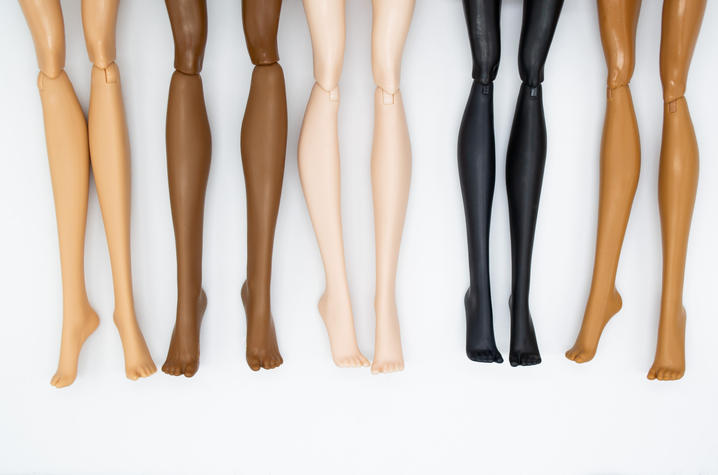
Op-ed: How new era of Barbie finally made me want a doll Research
The following op-ed was written by Aria Halliday, an associate professor in the Department of Gender and Women's Studies, African American and Africana Studies and International Film Studies in the College of Arts and Sciences at the University of Kentucky.
Growing up, I was — what we called in the 90s — a “tomboy.” Other than the dreadful laffy taffy-colored taffeta dresses with ruffles and white lace-trimmed socks, which my mother forced us to wear on special occasions, I avoided dresses as much as possible. It wasn’t a gender statement, per se. I simply didn’t see the point, especially during everyday play.
I felt the very same way about Barbies — and dolls, in general. Pillow forts, sleeping bag slides and riding bikes was more fun.
The few dolls my older sister had featured arms and heads turned in strange directions with hacked-off hair. To me, they were weird. And I didn’t like them. Often, my mom donated them to Goodwill, instead of passing them down. In the doll world, I would have been dubbed “does-everything-but-play-with-dolls Barbie.”
Fast forward 20 years, I began researching and studying Black girls and their experiences with dolls. I quickly found, their perspective isn’t often included — especially regarding research about the impact dolls have on brain development, play, empathy building and care.
Yes, “doll tests” were included in the Brown v. Board of Education of Topeka, Kansas case to determine Black children were harmed by segregation. Otherwise, this demographic was not considered or represented in the social and psychological research surrounding dolls.
Even though, Mattel’s Black dolls — Colored Francie (1967), Julia (1968) and Black Barbie (1980) — have been around for nearly 60 years, there has been little acknowledgment of Black consumers love for Barbies or Black women’s contributions to the creation of iconic Barbie designs until recently.
Enter Nicki Minaj and her first major label album, “Pink Friday,” in 2010. With bright pink costumers and two-toned wigs, Minaj gave Black girls of my generation permission to be hyperfeminine — even if it was with hip hop bravado.
Overnight, it seemed as if every Black girl I knew was imitating Minaj’s “sexy Barbie aesthetic.” As I discuss in my book, “Buy Black: How Black Women Transformed US Pop Culture,” the popstar inserted Black girls into Barbie world — propelling a generation forward and creating a space for those who were feminine, but a bit quirky, like myself.
This year, along with rapper Ice Spice, Minaj once again inserted us into Barbie’s Dreamhouse with their hit, “Barbie World.” Not only were Black girls now at the center of Aqua’s Barbie World sonic resurgence, Minaj’s popularity forced Mattel to make some different decisions in how they crafted, merchandised and promoted the Barbie movie.
With actors of color (America Ferrera, Ncuti Gatwa, Simu Liu, Issa Rae, among others) Greta Gerwig’s Barbie (2023) followed “stereotypical Barbie” through a dream world — featuring body-positive curvy dolls, disabled dolls in wheelchairs and dolls that were just quirky, like Kate McKinnon’s character.
The Barbie movie gave new meaning and value to my sister’s “weird” Barbies that had been shoved into drainpipes or damaged by toasters. And it made me question — might have I been wrong about Barbie’s imaginative possibilities so many years ago?
It was apparent, Gerwig was committed to calling out the problematic societal expectations that long made Barbie unattainable for girls like me. She also used the movie to comment on the pressure we, as consumers, have put on the doll since Handler’s invention of Barbie in the late 1950s. For these reasons, when it comes to Barbie, there is more to consider — beyond my own ambivalent feelings.
I came to a realization.
While conducting research for my book, I spoke with many Black women creatives and designers who previously worked with Mattel. And what they were trying to explain then, holds true now — a doll that is supposed to fix all of our problems, yet still be a play-thing that allows children and adults of all ages to make sense of their world, is exactly what Barbie has been and is the promise that she holds for all of us.
The movie cemented this idea for me, especially through the interrogation of the “and Ken” adage that Barbie is as problematic as we are. She has evolved with us — as we challenge ideas of race, beauty, gender, ability and status.
Barbie may never shake her thin, white, blonde and hyperfeminine origins. But Gerwig’s Barbie allows us to figure out where she might fit, in a world increasingly unfit for any of us (especially the weird, flat-footed and self-conscious me).
Now, I’m headed to Goodwill to discover Barbie and start my collection. Maybe, just maybe, I’ll see you there.